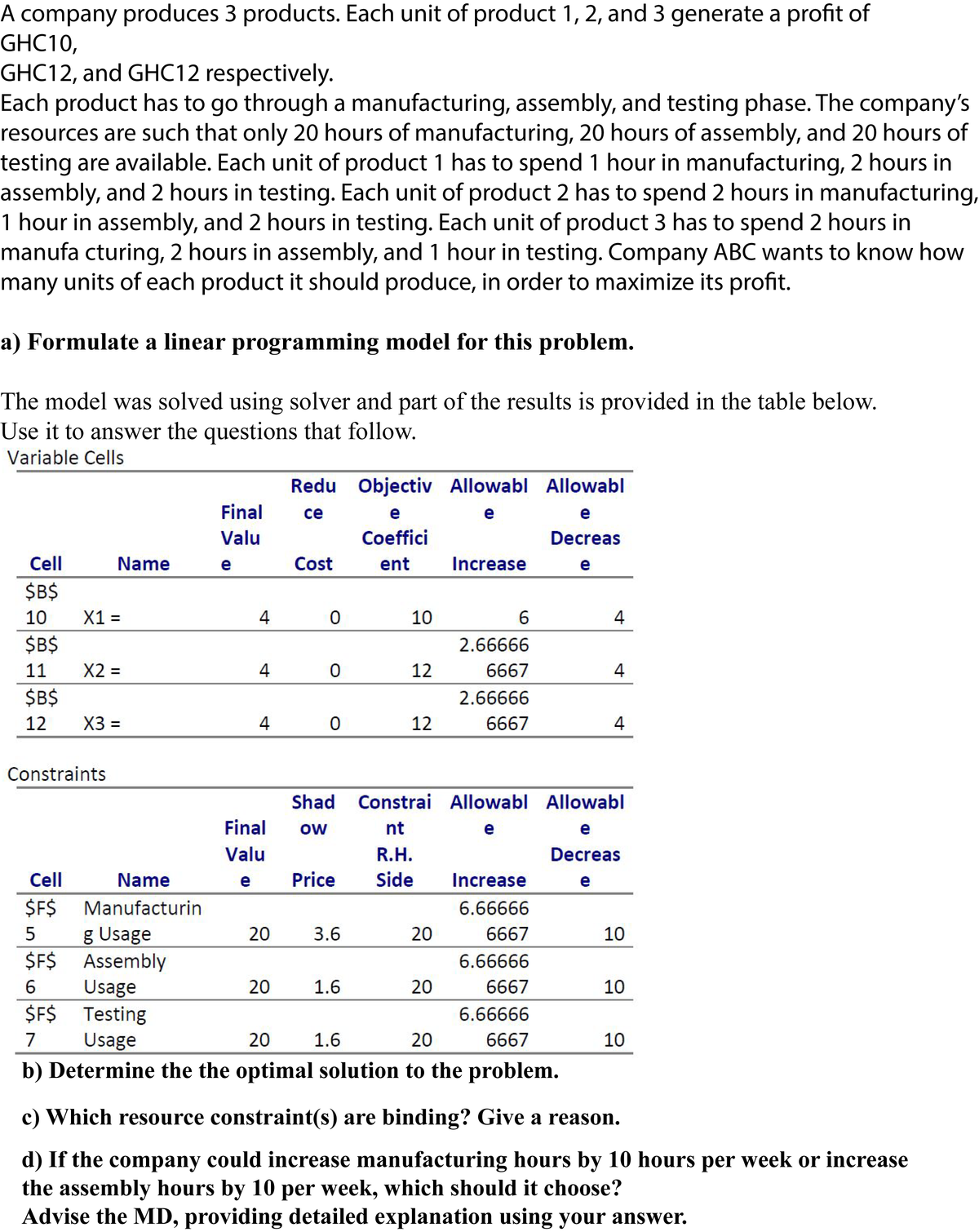A company produces 3 products. Each unit of product 1, 2, and 3 generate a profit of GHC10, GHC12, and GHC12 respectively. Each product has to go through a manufacturing, assembly, and testing phase. The company's resources are such that only 20 hours of manufacturing, 20 hours of assembly, and 20 hours of testing are available. Each unit of product 1 has to spend 1 hour in manufacturing, 2 hours in assembly, and 2 hours in testing. Each unit of product 2 has to spend 2 hours in manufacturing 1 hour in assembly, and 2 hours in testing. Each unit of product 3 has to spend 2 hours in manufa cturing, 2 hours in assembly, and 1 hour in testing. Company ABC wants to know how many units of each product it should produce, in order to maximize its profit. a) Formulate a linear programming model for this problem. The model was solved using solver and part of the results is provided in the table below. Use it to answer the questions that follow. Variable Cells
A company produces 3 products. Each unit of product 1, 2, and 3 generate a profit of GHC10, GHC12, and GHC12 respectively. Each product has to go through a manufacturing, assembly, and testing phase. The company's resources are such that only 20 hours of manufacturing, 20 hours of assembly, and 20 hours of testing are available. Each unit of product 1 has to spend 1 hour in manufacturing, 2 hours in assembly, and 2 hours in testing. Each unit of product 2 has to spend 2 hours in manufacturing 1 hour in assembly, and 2 hours in testing. Each unit of product 3 has to spend 2 hours in manufa cturing, 2 hours in assembly, and 1 hour in testing. Company ABC wants to know how many units of each product it should produce, in order to maximize its profit. a) Formulate a linear programming model for this problem. The model was solved using solver and part of the results is provided in the table below. Use it to answer the questions that follow. Variable Cells
Practical Management Science
6th Edition
ISBN:9781337406659
Author:WINSTON, Wayne L.
Publisher:WINSTON, Wayne L.
Chapter6: Optimization Models With Integer Variables
Section: Chapter Questions
Problem 49P
Related questions
Question
Linear programming company-1

Transcribed Image Text:A company produces 3 products. Each unit of product 1, 2, and 3 generate a profit of
GHC10,
GHC12, and GHC12 respectively.
Each product has to go through a manufacturing, assembly, and testing phase. The company's
resources are such that only 20 hours of manufacturing, 20 hours of assembly, and 20 hours of
testing are available. Each unit of product 1 has to spend 1 hour in manufacturing, 2 hours in
assembly, and 2 hours in testing. Each unit of product 2 has to spend 2 hours in manufacturing,
1 hour in assembly, and 2 hours in testing. Each unit of product 3 has to spend 2 hours in
manufa cturing, 2 hours in assembly, and 1 hour in testing. Company ABC wants to know how
many units of each product it should produce, in order to maximize its profit.
a) Formulate a linear programming model for this problem.
The model was solved using solver and part of the results is provided in the table below.
Use it to answer the questions that follow.
Variable Cells
Redu Objectiv Allowabl Allowabl
Final
се
e
e
e
Valu
Coeffici
Decreas
Cell
Name
e
Cost
ent
Increase
e
$B$
10
X1 =
4
10
6
4
$B$
2.66666
11
X2 =
4
12
6667
4
%3D
$B$
2.66666
12
X3 =
4
12
6667
4
%3D
Constraints
Shad
Constrai Allowabl Allowabl
Final
ow
nt
e
e
Valu
R.H.
Decreas
Cell
Name
e
Price
Side
Increase
e
$F$
Manufacturin
6.66666
g Usage
$F$ Assembly
Usage
$F$ Testing
20
3.6
20
6667
10
6.66666
6.
20
1.6
20
6667
10
6.66666
Usage
b) Determine the the optimal solution to the problem.
7
20
1.6
20
6667
10
c) Which resource constraint(s) are binding? Give a reason.
d) If the company could increase manufacturing hours by 10 hours per week or increase
the assembly hours by 10 per week, which should it choose?
Advise the MD, providing detailed explanation using your answer.
Expert Solution
This question has been solved!
Explore an expertly crafted, step-by-step solution for a thorough understanding of key concepts.
Step by step
Solved in 4 steps with 4 images

Recommended textbooks for you

Practical Management Science
Operations Management
ISBN:
9781337406659
Author:
WINSTON, Wayne L.
Publisher:
Cengage,

Practical Management Science
Operations Management
ISBN:
9781337406659
Author:
WINSTON, Wayne L.
Publisher:
Cengage,